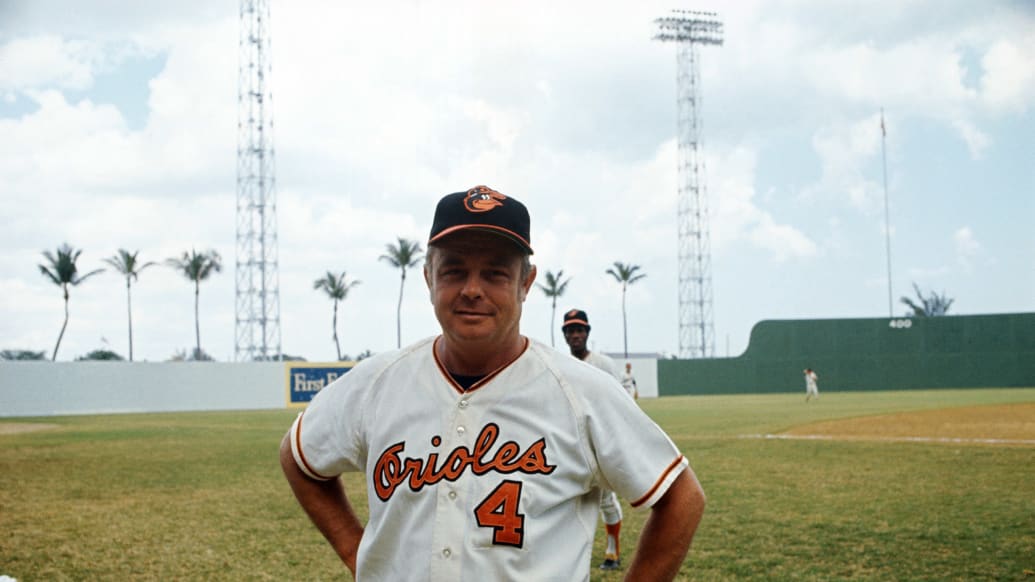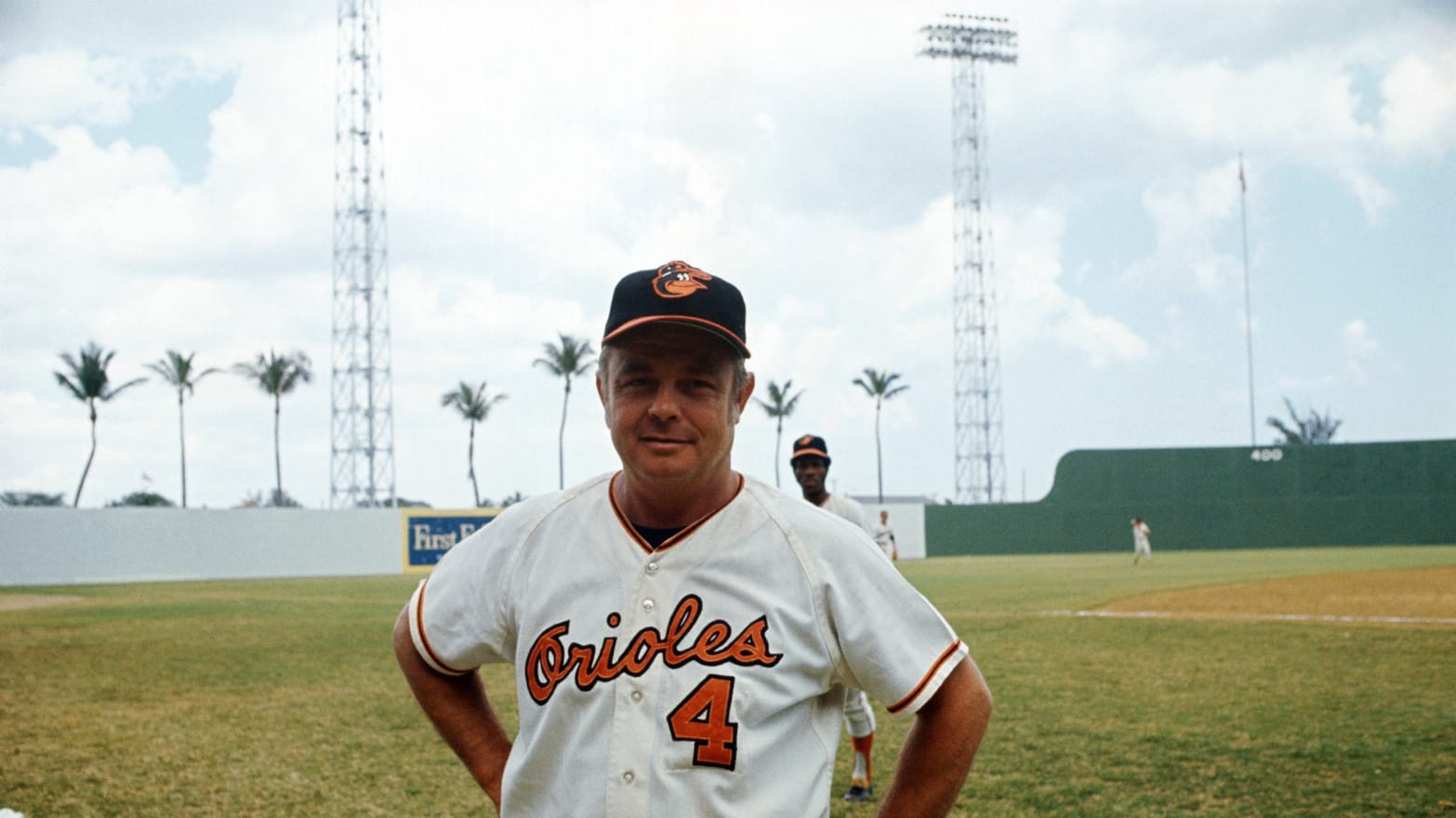It’s Sept. 17, 1980, and Earl Weaver, the great Baltimore Orioles manager who died Friday night at 82, is shouting down umpire Bill Haller at the old Memorial Stadium.

“You’re here, and your crew is here, just to fuck us!” he hollers, and as soon as he’s run from the game, he’s off, invoking ancient grievances and threatening to knock Haller right in the nose.
It’s the top of the first inning.
That film exists of this is a little miracle, and that it confirms every hope you ever had about what Weaver was saying during his many, many arguments with the men in blue just makes it better. (In his essential book Weaver on Strategy, he ran charts detailing the 99 times he was thrown out of a game, both chronologically and by umpire.) The lasting image of the five-foot-six Weaver is of him either turning his cap around so as to be able to get closer in while screaming at an umpire or actually kicking dirt on one, and this made him more or less the ideal form of the cantankerous, irascible manager.
If there was no professional baseball, Bill James once wrote, “he’d have been a bouncer at a midget bar.”
What made the act so funny, though, was that he was also truly great—not easy in a sport where even a decent manager makes about as much difference as a tea cozy. From 1958 to 1985, he never had a losing record, in the minors or the majors. From 1969 to 1980, his Orioles averaged 96 wins a year and won four pennants and a World Series. During that span, 9 different pitchers, backed by what was almost certainly the best defense ever assembled, won 20 or more games for him a total of 21 times. No one has done the job better since his retirement in 1986, and it’s possible that no one ever will.
Among baseball wonks, Weaver is beloved not just for a mouth (NSFW) that would embarrass Chief Keef, but for being as far ahead of our time as he was his own; before James had ever published a word, Weaver was running his team by principles more advanced than those that rule the game today. In his book on strategy, he laid down 10 laws—“If you play for one run, that’s all you’ll get,” i.e.—that sum up in plain language all the findings of the most sophisticated statistical research done over the last 40 years, and if a reporter had closely followed the Orioles during the Nixon administration, he could have written Moneyball while Michael Lewis was still in grade school.
Winningly, though, Weaver was hardly some bloodless accountant. He was running the numbers at a time when nearly no one else, in or out of the game, was doing so, but as the great Leonard Koppett argued in his book The Man in the Dugout, he used them mainly as a tool of persuasion.
“In Earl’s own mind,” Koppett wrote, “he knew what he wanted to do and why. Naturally, the numbers confirmed his opinion the vast majority of the time: he had formed his opinion by noticing and remembering—as all good managers do—what had happened to make the numbers what they were. But he didn’t draw his conclusions from the numbers; he chose the numbers that suited his conclusion.”
Weaver, in other words, anticipated modern analysis not because he paid attention to the data, although he did, but because of a profound baseball intelligence that grasped the shape and depth of the game in a way few others have. That may have been because of his unique schooling. Growing up in St. Louis, he started hanging around major-league clubhouses at 6—his father handled the dry cleaning for the two clubs that were in the city at that time—and he would take in 100 games a year at Sportsman’s Park. One of his good friends was an office boy for Branch Rickey, the legendary general manager, and a family friend had been Babe Ruth’s roommate. Steeped as he was in the game, he was naturally a hell of a player, and at 13 the Hall of Famer George Sisler, at the time a Cardinals scout, called his father to look into signing him.
“He won’t be 14 until August,” said the elder Weaver.
Earl never grew, though, and so while he played in the minors for years, he never came to much. He was so obviously a manager, though, that he got his first minor-league job at 25, and after brief flirtations with real work—at one point, he was a management trainee with a loan company, an experience he continually referred to later in life as having taught him an awful lot about people—he settled into a baseball career. At 37, he was running the Orioles.
In his long apprenticeship, he’d figured out many things that many of his rivals never would, among them—and this is depressingly rare among managers—that every player is unique and has to be treated as a man and not a cog in a grinding machine.
When working in the bushes, to give an example, he came across a pitcher named Steve Dalkowski, who supposedly threw 120 miles per hour and couldn’t win a game. (One year he struck out 262 men in 170 innings, walked as many, and finished 7–15.) Weaver, as Bill James has the story, insisted on giving his players IQ tests; Dalkowski allegedly came in at 60. Having surmised the problem, Weaver told the pitcher to not worry about anything and just throw the ball over the plate, after which he started pitching much better (before eventually blowing his arm out).
“You run into people like Mike Epstein,” Weaver wrote, “who wanted to convince you he knew something about Socrates. You run into guys who just want to go out and get into fights. You can’t put people into categories. No matter what they’re like, my job is to get the most out of them as players.”
What carried over from this acknowledgment of human individuality is that Weaver knew that while every player had a distinct set of quirks he had to deal with, they also had distinct sets of skills that he had to figure out how to use. He would play a fat guy who could do nothing but draw walks and hit the ball hard, or a skinny little guy with a great glove and nothing else, or a pitcher with a perpetually sore arm but great stuff, or a smart pitcher who couldn’t break glass with his fastball. His only requirement was that you do something well. If you did, he could figure out what to do with you. (“In later years,” James wrote, “he used a bewildering rotation system which involved not only platooning at four or more positions, but also three-man and four-man platoons, offensive and defensive specialists, and curveball/fastball platoons.”) He didn’t believe that being bad at something he valued made you lousy; it just made you bad at that one particular thing, but still a potential contributor to a great team.
“A winning player,” he wrote, “is nothing more than a player on a winning team. A losing player is a guy who played on a losing team that year.”
Another thing he learned was that a manager is, in many and perhaps most circumstances, nigh useless. Weaver’s 10th law is this: “The job of arguing with the umpire belongs to the manager, because it won’t hurt the team if he gets thrown out of the game.” Those 99 ejections came not because he had it in for the umpires; as Koppett wrote, he was “immensely good-natured” and “obviously free of malice,” and the men on whom he kicked dirt loved him. He got tossed, rather, because he figured that it was better for a middle-aged man standing five feet six to get into it with someone like Bill Haller than for the cleanup hitter to do so.
One consequence of this insight was his ability to write off all the inside-baseball things that managers do to make themselves look clever—call bunts and hit-and-run plays, devise a running game, etc.—as dumb and usually useless. He knew what math has since taught baseball fans (Weaver’s fourth law: “Your most precious possessions on offense are your 27 outs”), and he loved the walk, the three-run home run, and players who could do useful things.
“The home run makes managing simple,” he wrote. “Frank Robinson would come to bat with two guys on base. I’d yell, ‘Hit it hard, Frank.’ Frank would hit it hard and far, over the fence. Then he would come around the bases and back into the dugout. I’d say, ‘Nice hit, Frank.’ Now that is that ideal way to manage, and that’s how people first decided I was smart.”
For all his infamous quarreling and scrapping, Weaver did a lot of good for a lot of people. He broke great players like Don Baylor, Bobby Grich, Eddie Murray, and Cal Ripken Jr. (whom probably no one else would have let play shortstop) into the majors and was indelibly associated with others like Mark Belanger, Brooks and Frank Robinson, and Jim Palmer. Baylor and Davey Johnson went on to long, successful managerial careers after playing under him, and many of his coaches, like George Bamberger, Jim Frey, Billy Hunter, Ray Miller, Cal Ripken Sr., and Frank Robinson, went on to manage as well. All along, he wasn’t just running a great ball club, but the best baseball school to be found anywhere in the world.
And when he was done—when, in 1986, he put up his first losing major-league season in 17 tries, at age 55, which isn’t at all old for a manager—he went away. He was no carping presence, talking about how things were done in his day. The worst he did, in a 2002 update to Weaver on Strategy, was complain about how stupid it is that some people can’t manage to figure out that it’s better to not make an out than to do so: “Strange but true, it seems that some general managers and managers still don’t understand the value of the base on balls.”
In all, the man was unimpeachable, and unimprovable, and if through some fluke of science he were able to come into the majors today as a young man, he would still be years beyond anyone else running a club. Baseball doesn’t have much to do with too many people who approach genius. It just lost one of the few who did.

